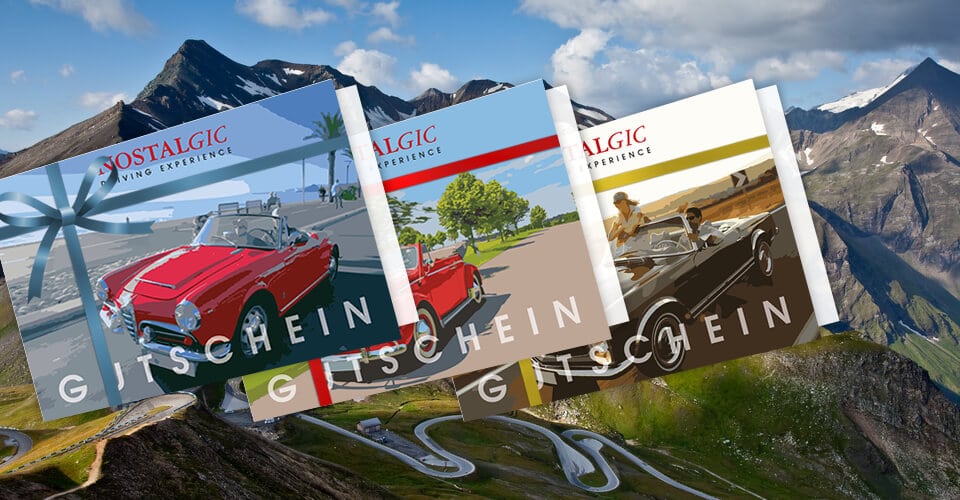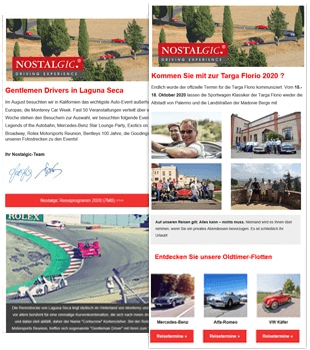
The sound of this brand is enough to get you excited: Its association with Italy, and with sporty vehicles rivals none. Alfa Romeo stands for long-term technological leadership in engine construction, for successful design, and finally for Italy's longing for automobiles for all people in the north.
Advertisements from the 1950s praised and demonstrated the high-class position of the Alfa Romeo brand. It's an Alfa Romeo, “An automobile that not everyone has, but a car that reveals the way of life.” In addition, the Alfa Romeo automobiles were, “Only built for people who are characterized by their young heart, their car understanding and their enthusiasm for the beauty of driving”.
Whatever one's personal attitude towards Alfa Romeo is, one thing is certain: the ideal way for you to go on an adventure trip to the 1950s on dream roads in Italy is from behind the wheel of an Alfa Romeo.
Dolce Vita and Alfa Romeo belong together like Roberto Rossellini and Ingrid Bergman, like Celentano and “Azzurro,” and especially like fashion and Italy. Nowhere else is this best reflected in the Italian way of life than with an Alfa Romeo.
Just one year after hitting the open roads, this model took on the oldest car race in the world; founded by the Sicilian magnate Florio: the "Targa Florio". But the current operators were not very lucky: In 1915, stock speculators ensured that an armaments company led by Ing. Nicola Romeo produced military equipment in Portello for the ongoing war.
1919 was when automobile manufacturing returned in Milan, and it was now under the name “Alfa-Romeo” (initially with a hyphen). As with other automakers in the roaring twenties, the fate of Alfa Romeo lied in the hands of wealthy financiers and their friends who recognized the dawn of a new era of cars to come.
Alfa's chief designers Giuseppe Merosi and Vittorio Jano who said that the new models should rely on large-volume four- and six-cylinder engines. The successes in the following races proved them right, and inspired Alfa Romeo's sales success. Alfa Romeo drivers included legends such as Antonio Ascari, Giuseppe Campari, Tazio Nuvolari and, of course Enzo Ferrari, who later founded his own automobile factory.
The first automobile world championship in 1925! Of the eleven participating car brands at the time, only four of those are left today: apart from Alfa Romeo, these are Mercedes-Benz, Fiat and Bugatti. However, Alfa Romeo had a legacy during these prestigious events with two first-place victories in Spa and Monza! The driver for these races was Gastone Brilli-Peri, he won in a 2-liter eight-cylinder type P2 with 140 hp and a top speed of 225 km / h.
The winner's podium of 1927 for the Mille Miglia belonged to Alfa Romeo drivers and their automobiles for a decade, with only one exception.
During a recession and a stock market crash, worsening the economic situation in the automotive industry, we can thank the car-enthused national poet Gabriele D’Annunzio and/or his supporter Benito Mussolini for considering Alfa Romeo as a national cause, rallying support for the brand and thus changing hands to the Istituto per la Ricostruzione Industriale(IRI), saving the cars as we know them.
Alfa Romeo delivered more than expected solely based on its experience in racing: limousines, coupés and convertibles, like the 6 C 2300 or the 8 C 2900, which, in the thirties, was the fastest production car in the world with a top speed of 205 km / h.
After the Second World War, the market for automobiles, like those ordered by Hollywood greats like Charlie Chaplin or Rita Hayworth, was simply too small.
That was why Alfa Romeo was one of the first car manufacturers to choose the "series production" strategy, of doing the same models in different body shapes. This leveled the Milanese brand and gave access to a broader group of buyers than before.
Almost everything that was necessary for this change was already there: Alfa Romeo's reputation as atechnology leader, the big names of the pre-war coachbuilders, and a committed team in the main factory in Portello, which quickly repaired the war damage.
The Gielietta Sprint in 1954 was presented to the world! We owe its creation to the original decision after the war. In quick succession, this technically-excited new model (see Giulietta Spider) would be accompanied by a sedan and a convertible, which would ensure that everyone who could afford it drove an Alfa Romeo.
In 1957 more Alfa Romeos were produced than in the company's entire history to that point. During the post-war period, there was an unusually large product variety, with a range of coupes, convertibles and sedans, Alfa Romeo even served Europe's jet set between Amalfi, Cortina, St. Tropez and Portofino in the 1950s and 1960s.
Americans have also been enthusiastic about Alfa Romeo. The sonorous brand not only owns one of the most beautiful emblems in the automotive industry; the red cross on a white background of the city of Milan and the dragon from the Visconti coat of arms, but, as early as 1962, the successor was ready: the legendary Giulia, for many, the epitome of the sporty sedan.
The 1960s was a staple of Alfa Romeo's meteoric rise: The move from the Portello district to Arese, north of Milan, was a symbol of this.
During the heyday of motorsport, supervised by the in-house racing department Auto Delta, it was the time when comparable models from Alfa Romeo were more expensive than those from BMW - many people can only guess the reason why the Munich-based company had marginally better sales figures.
Some people assumed structural problems, e.g. the productivity of the plants, possibly politically motivated influence on the management (Alfa Romeo had been a de facto state-owned company since 1933), or maybe internal trench warfare over design and technological developments characterizing the 70s with Alfa Romeo.
During this time, a number of unshakable fans remained loyal to Alfa Romeo, however sales for the Milan-based brand continued to fall below expectations, especially abroad.
The attempt by Alfa Romeo to return to luxury class with six-cylinder engines, which had been attempted previously, had not met with lasting success. The majority of Alfa Romeo models were sporty sedans such as the 75th-year anniversary model "Alfa 75" which successfully appealed to Alfa fans, but the unique sporting feature was no longer limited to the Alfa Romeo brand.
Like the many decades before, Alfa Romeo, during the mid-1980s, in the most difficult economic waters, when the company was declared a national cause by industrial patriarch "Avvocato" Gianni Agnelli and taken over by the Italian Fiat group. Today the brand belongs to the Stellantis Group.
Now in Germany, Alfa Romeo remains one of the most popular car brands, the image of Alfa Romeo inspires the trade press, and the Giulia (sedan) and Stelvio (SUV) models are currently on offer.
| Engineering Information | |
|---|---|
| Bodywork: | Pininfarina |
| Model variants / construction time: | 1955-1959 (750D), 1959-1962 (101.03) |
| Motor: | Four cylinders in line, water-cooled |
| Motor installation position: | front, lengthways |
| Drive | Rear |
| Wheelbase | 2.200 (750D)/ 2.250 (101.03) |
| Length / Width / Height (mm): | 3.850 / 1.580 / 1.335 (750D) 3.900 / 1.580 / 1.500 (101.03) |
| Empty weight | 830 kg (750D)/ 865 kg (101.03) |
| Wheel size | 155-15 |
| Tank capacity | 53 l |
| Consumption | 9 l/100 km |
| Engine versions | |
|---|---|
| Type: | 750D |
| Displacement (cm3): | 1.290 |
| Power (kW / PS - at min-1): | 48/ 65/ 6.000 |
| Top speed | 160 km/h - 100mph |
| Type: | 101.03 |
| Displacement (cm3): | 1.290 |
| Power (kW / PS - at min-1): | 59/ 80 / 6.000 |
| Top speed | 165 km/h - 107mph |
| Engineering Information | |
|---|---|
| Bodywork: | Pininfarina |
| Model variants / construction time: | 1962-1965 |
| Motor: | Four cylinders in line, water-cooled |
| Motor installation position: | front, lengthways |
| Drive | Rear |
| Wheelbase | 2.250 |
| Length / Width / Height (mm): | 3.900 / 1.580 / 1.335 |
| Empty weight | 885 kg |
| Wheel size | 155-15 |
| Tank capacity | 53 l |
| Consumption | 10 l/100 km |
| Engine versions | |
|---|---|
| Type: | 101.23 |
| Displacement (cm3): | 1.570 |
| Power (kW / PS - at min-1): | 68 / 92/ 6.000 |
| Top speed | 175 km/h - 109 mph |
| Engineering Information | |
|---|---|
| Bodywork: | Pininfarina |
| Model variants / construction time: | 1967 – 1969 |
| Motor: | Four cylinders in line, water-cooled |
| Motor installation position: | front, lengthways |
| Drive | Rear |
| Wheelbase | 2.250 |
| Length / Width / Height (mm): | 4.250 / 1.630 / 1.290 |
| Empty weight | 1040 kg |
| Wheel size | 165 HR 14 |
| Tank capacity | 46 l |
| Consumption | 11,4 l/100 km |
| Engine versions | |
|---|---|
| Type: | 105.57 |
| Displacement (cm3): | 1.779 |
| Power (kW / PS - at min-1): | 48/ 65/ 6.000 |
| Top speed | 160 km/h - 100mph |
| Type: | 101.03 |
| Displacement (cm3): | 1.290 |
| Power (kW / PS - at min-1): | 97 / 115 / 5.000 |
| Top speed | 190 km/h - 118mph |
| Engineering Information | |
|---|---|
| Bodywork: | Pininfarina |
| Model variants / construction time: | 1972-1982 |
| Motor: | Four cylinders in line, water-cooled |
| Motor installation position: | front, lengthways |
| Drive | Rear |
| Wheelbase | 2.250 |
| Length / Width / Height (mm): | 4.120 / 1.630 / 1.290 |
| Empty weight | 1020 kg |
| Wheel size | 165 HR 14/ 185 HR 14 |
| Tank capacity | 51 l |
| Consumption | 11,5 l/100 km |
| Engine versions | |
|---|---|
| Type: | 105.24 |
| Displacement (cm3): | 1.962 |
| Power (kW / PS - at min-1): | 97 / 132 / 6.000 |
| Top speed | 190 km/h - 118mph |

Balanstraße 73 / 81541 München
Office: +49 (0)89 5454060
Fax: +49 (0)89 5454066
E-mail: info@nostalgic.de

Register for the Nostalgic Newsletter

Join over 5000 other Classic Car fans!
Subscribe to the free newsletter now and be inspired!